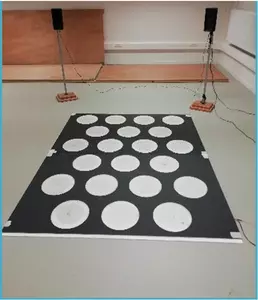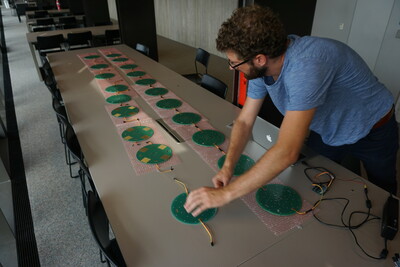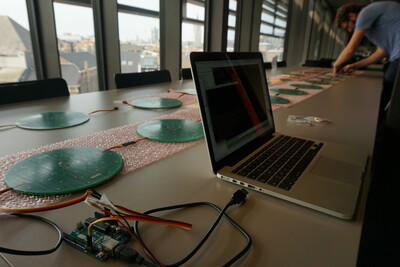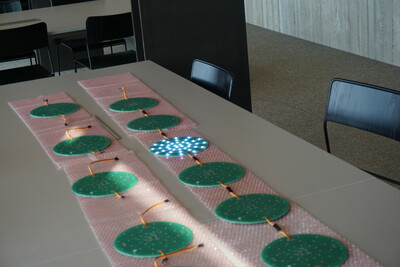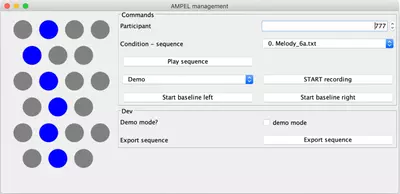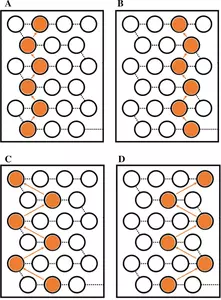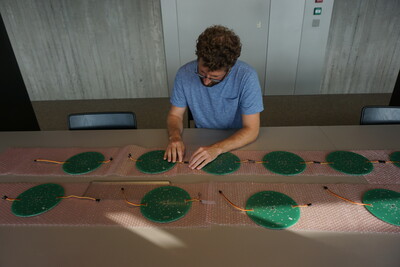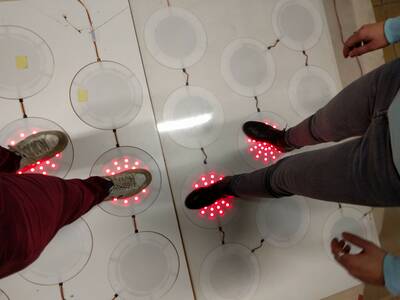~ The Augmented Movement Platform For Embodied Learning (AMPEL)
» By Joren on Friday 22 April 2022I have been lucky to be part of a fruitful interdisciplinary scientific collaboration around AMPEL: ‘The Augmented Movement Platform For Embodied Learning’. The recent publication of an article is an ideal occasion to give a glimpse behind the scenes.
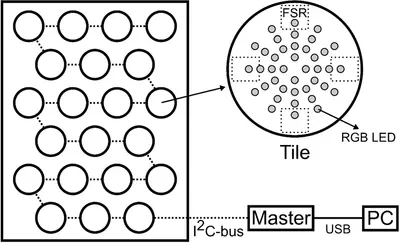
Fig: Schematic representation of AMPEL, a floor with interactive tiles.
Around 2016 the idea arose to search for new potential rehabilitation approaches for persons with multiple sclerosis. Multiple sclerosis causes problems, in varying degrees, with both motor and cognitive function. Common rehabilitation approaches either work on motor or cognitive function. The idea (by Lousin Moumdjian, Marc Leman, Peter Feys) was to combine both motor and cognitive rehabilitation in a single combined ‘embodied learning’ paradigm.
After some discussion we wanted to perform a combined short-term memory and walking task. First the participants would be presented with a target trajectory which would then be performed by walking. During walking we would modulate feedback types (melodic, sounds or visual). To this end, an ‘intelligent floor’ device was needed that was able to present a target trajectory, register a performed trajectory and provide several types of feedback. After a search for off-the-shelf solutions it became clear that a custom hard-and-software platform was required.
After a great deal of cardboard prototyping we settled on a design consisting of interactive tiles. Thomas Vervust of UGhent NamiFab designed a PCB with force sensitive resistors (FSR) on the bottom and RGB LED’s on top. Ivan Schepers provided practical insights during prototyping and developed the hardware around the interactive tiles. I was responsible for programming the system. Custom software was developed for the tiles, a controller to drive the tiles and to run and record experiments. Finally the system was moved to a hospital where the experiments took place. To know more about the exact experiments, please read the following three publications on AMPEL:
-
The Augmented Movement Platform For Embodied Learning (AMPEL): development and reliability - 2021
Moumdjian, L., Vervust, T., Six, J., Schepers, I., Lesaffre, M., Feys, P., & Leman, M.
This article details the rationale behind AMPEL and provides technical details and reliability measurements. It was published in the Journal on Multimodal User Interfaces -
Embodied learning in multiple sclerosis using melodic, sound, and visual feedback: a potential rehabilitation approach - 2022
Moumdjian, L., Six, J., Veldkamp, R., Geys, J., Van Der Linden, C., Goetschalckx, M., Van Nieuwenhoven, J., Bosmans, I., Leman, M. and Feys, P.
The main AMPEL study which presents the rehabilitation potential. This work was published in the Annals of the New York Academy of Sciences. -
[Motor sequence learning in a goal-directed stepping task in persons with multiple sclerosis: a pilot study\
- 2022](https://nyaspubs.onlinelibrary.wiley.com/doi/10.1111/nyas.14702)
Veldkamp, R., Moumdjian, L., van Dun, K., Six, J., Vanbeylen, A., Kos, D. and Feys, P.
For this study AMPEL was slightly modified for a reaction time task, showing its flexibility. The participants were asked to step on a tile as quickly as possible after it lit up. They were either knowledgable of the tile trajectory or not. This work was also published in the Annals of the New York Academy of Sciences.
- 2022](https://nyaspubs.onlinelibrary.wiley.com/doi/10.1111/nyas.14702)

